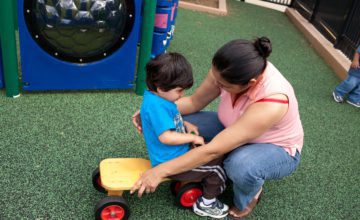What It’s Like for You
By now, you might be feeling more confident about caring for your baby. However, if you have a baby who is colicky or who tends to be fussy, things might still feel a little rocky at times. Hang in there. Over the next few weeks and months, you will begin to better understand what many of your baby’s signals mean and what her rhythms are.
Right around 3 months is also the time when your child becomes more aware of the world around her and the people in it (like you!). This awareness leads to the beginning of back-and-forth play as Chris, father to Jacob (3 months), found: I was holding Jake and smiled at him. He smiled back. I held out my finger, and he grabbed it. I started telling him how he was going to be a great basketball player someday, and he gurgled at me when I was done, like he was actually saying something. It was one of the first times I felt like he really knew who I was. It was pretty cool.
As your baby begins to stay awake and alert for longer periods during the day, it gets even more fun for the two of you to do things together, like taking walks and visiting friends and family. You may even find that your little one is eating and sleeping more regularly. This makes life a little more predictable for both of you.
What It’s Like for Baby
Today I woke up so hungry from my nap! I cried for you, and you answered me right away. You said, I hear you, Sweetie. I’m just folding up the last shirt in the laundry basket. I’ll be right there. While I didn’t know what those words meant, the sound of your voice reassured me and helped me feel calmer. I knew you would be coming soon. But I didn’t stop crying—no way! I needed you to know that I wanted some milk, so I kept making unhappy noises and sucked on my fingers until you came. When you reached in and picked me up, you smiled and said, You sound hungry. Come and let’s have a snack. I calmed down right away. You understood. Milk, here I come!
What Your Baby Is Learning
Language Development:
- That by using her cries, facial expressions, and body movements she is an effective communicator because you respond. This motivates her to keep on communicating.
Thinking Skills:
- That her hunger pains are connected to food, and that her source of food is…you! Your baby then uses her communication skills (crying) to “tell” you that she is ready to eat. This process of making connections, that Mommy = milk = satisfying hunger, is an important thinking skill your baby is developing. And it’s pretty sophisticated behavior for a 3-month-old!
Social-Emotional Development:
- That she can trust you to understand her needs and take good care of her. This gives her the confidence to trust others, which will help her form healthy relationships as she grows.
- That some distress is manageable. Your child is learning that feeling upset, while unpleasant, is temporary—that someone who loves her will be there to help her manage these feelings. Over time, she learns that feelings of distress can be dealt with and will pass.
What to Expect From Your Baby’s Development
As you review the chart, keep in mind that development is not a race and that every child grows at her own pace and in her own way. Your child may develop skills faster or slower than indicated below and still be on track. If you have questions or concerns, talk with your child’s health care provider or other trusted professional.
Your Toddler’s Development From 3 to 6 Months
| What Your Baby Can Do | What You Can Do to Connect With Your Baby |
|---|---|
I am learning to control my body. |
|
|
|
I use my hands and fingers to explore. |
|
|
|
I communicate by using sounds, actions, and facial expressions. |
|
|
|
I am ready for books. |
|
|
|
I am getting used to the world around me. |
|
|
|
Did You Know…
Babies whose mothers reported high life stress cried and fussed more than babies whose mothers reported little stress? (For this research, babies were studied at 6 weeks and then again at 3 months and 6 months.)
What the Research Means For You
Even very young babies pick up on how their loved ones are feeling. When you are relaxed and content, your baby is more likely to feel safe and secure. When you are feeling stressed and overwhelmed, your baby senses that too. That’s why one of the best things you can do to take care of your baby is to take care of yourself. Ask for help from trusted family and friends to give you time to do things that make you feel good. And if you are feeling down or depressed, be sure to talk to a health care provider. New parents need and deserve lots of support—not just in the first few weeks, but for the first year and beyond.
Spotlight on: Choosing Child Care
More and more infants and toddlers are spending time being cared for by someone other than their parents. Babies and toddlers need caregivers who understand how to promote their healthy growth and development. They also need people who can tune in to and respond to their individual needs. And all young children need lots of love and attention from nurturing adults who will talk and play with them. Read more about what makes a good caregiver and a high-quality infant-toddler child care program.
Loving and responsive
A loving and responsive caregiver looks like she really enjoys children. She hugs, rocks, cuddles, and has fun playing with them. She notices their interests and responds by offering them chances to explore the things that engage them. For example, if a baby shows a liking for a particular book, the caregiver may make this story part of the child’s naptime routine each day. Skilled caregivers get down on the children’s level and talk with them about what they are doing and seeing. They are playful partners who introduce new ideas, objects and games.
Respects the baby’s individuality
A good caregiver respects a baby’s individuality. She recognizes his personal rhythms, temperament, strengths and needs. She takes this information into consideration when planning the pace and time for eating, sleeping and playing. For example, for a baby who is very sensitive to lights and sound, the caregiver might decide to turn off any battery-operated noise-making toys in the room. Skilled caregivers also look for ways to accommodate children’s special needs or conditions.
Provides a stimulating and child-friendly environment
Caregivers create a play area that is clean and safe so babies can explore their surroundings. They fill the play space with interesting and stimulating things to touch, look at, and listen to. Caregivers ideally change the room (even just slightly) on a regular basis to accommodate the needs of growing babies and toddlers. They organize the room to have separate eating and diapering areas, provide soft, “cozy” areas for reading and cuddling, and create spaces that are comfortable for adults so that parents feel welcome to stay and be with their children when appropriate.
Before you sign on the dotted line
If at all possible, visit the program and watch the caregiver(s) interacting with the children in their care. Parents can learn a lot about a caregiver and program simply through careful observation. Here are some ideas as to what to look for and ask about when visiting a child care program:
To Ask About:
- What training do staff members have in infant-toddler development? Be sure you feel comfortable with their level of expertise and skill.
- What is the caregiver-to-child ratio (how many children are caregivers responsible for at any one time)? For babies, one caregiver for every three infants is a good minimum standard.
- For toddlers age 2 and up, one caregiver for every six children is a benchmark.
- Is each baby allowed to eat and sleep according to her own individual needs, and not based on a schedule set up by the caregiver?
- Are caregivers able to accommodate the special needs of children?
- What is the caregiver’s approach to discipline? Weaning? Toilet training? Feeding? Do the caregiver’s beliefs match your own?
- Are you welcome to drop in at any time?
To Ask Yourself:
Would your child feel good about coming here? Would you feel good about leaving your child here?
To Look for:
- Do caregivers speak to the children, even babies? Do they sing and read to the children?
- Do they answer children’s questions patiently? Do they ask children questions?
- For toddlers, is a daily schedule posted, using pictures and visuals, so that children can anticipate what will happen next?
- Are toys and materials well organized so that children can choose what interests them?
- Does the environment accommodate the special needs of children?
- Do caregivers respect the language, culture, and values of families in the program?
- Does the caregiver handle conflicts without losing patience, shaming a child, or frequently displaying anger?
- Does the caregiver seem to enjoy children?
- Is the environment sanitary and safe?
- Is the setting appealing with comfortable lighting and an acceptable noise level?
How Do You Locate Child Care?
- To locate child care in your area, contact your regional Child Care Resource and Referral Agency (CCR&R), which can help you find a provider close to where you are.
- To locate your nearest CCR&R, click here.
- To find a child care program that has been accredited by the National Association for the Education of Young Children, click here.
- To learn more about what this quality accreditation means for families, click here.
Let’s Play: Activities That Nurture Bonding and Learning
Airplane
Hold your baby securely in front of you. Gently move him so that he is “flying” through the air like an airplane. Carry him to interesting objects (near colorful toys, over a patterned rug, or near a mobile) and move him to different heights. (Be sure to watch for and respect his cues that he needs a break.)
Bicycle
Lay your baby on her back and gently move her legs back and forth as if she is pedaling a bicycle. You can also change the pace of the movements, going slower or faster. As you pedal, sing to her or talk with her about your game: Now let’s go up the hill…now dowwwwn the hill. Should we go fast or slow?
What’s on Your Mind?
1. My maternity leave is about to end and I’ve made plans to send my 3-month-old to child care. I thought I would be prepared for this, but as the date draws closer, I can’t help but worry that my baby will develop a closer attachment to her caregiver than to me. Should I be concerned?
Moms and dads are special to their children in ways that no one can replace. The bond between you and your child is stronger than all others. You will always be #1 for hugs and kisses, nose wipes, band-aid application, and night-time tuck-ins.
Even so, know that you are not alone in these worries. Many parents who “share the care” with child care providers also occasionally experience uncomfortable, hard-to-deal-with feelings such as jealousy, competition, and guilt. It’s important to be aware of these emotions, because when we act on them without thinking, it can have unintended negative consequences. For example, one mom who was worried about her son’s close attachment to his child care provider found herself limiting the time she spent with her son’s provider at drop-off and pick-up. When she did, the interaction was strained. You can see how this could be very confusing and upsetting to her son, and how it could create a very tense relationship between Mom and caregiver—which is never good for a child.
There may also be times when you find your child’s reactions to hellos and good-byes confusing. Your child might seem as though he doesn’t want to leave at the end of the day, as he clings to his caregiver and cries when you take him into your arms. While this may feel awful, it doesn’t mean your child loves his caregiver more than you. More likely, your child is “telling” you, I’m having such a good time here. I need a little time to adjust to the idea that it’s time to go. Or he might be saying, I missed you so much when you left. Then Ms. Peggy helped me have a good day. Suddenly, here you are. I need a little time to let go of Ms. Peggy and get reconnected with you again. Though these moments are hard, your child is letting you know that she can trust you with her strongest feelings.
Child care providers can be wonderful partners. They know a lot about your child. This information can be a rare gift. A strong relationship with your provider can actually enhance your relationship with your child, and help you see—in a new light—what a wonderfully interesting and lovable person you are raising.
2. I’m home with my 3-month-old all day every day. I try to stimulate her with toys and books, but she’s not that interested in them. Is something wrong?
This is not unusual at all. During the first 3 months, babies are using most of their energy to adapt to the outside world. There may be periods when she enjoys looking at her toys (show her bright ones she can easily see) or listening to your voice as you read stories. But some babies are still more interested in sleeping and eating than playing.
What’s most important in these early months is to follow your baby’s cues. Comfort her when she is distressed; interact with her when she is alert and ready for play. By the fourth month you will see her become more interested in exploring and learning about the world around her.
Right around 12-14 weeks, you might see your baby grasping small toys like rattles with her hands, looking carefully at colorful objects and illustrations in books, and mouthing and chewing on her teethers or other toys. This may only last a few minutes. Then you’ll notice that she might look away, drop the toys, close her eyes, or even start to cry. This is her way of saying, Okay, I need some rest time now. Put the toys away and give her the break she needs, either by cuddling or swaddling her, or by putting her down in the crib for a few minutes. She will show you when she’s ready to play again by looking eager and alert. If you don’t see your daughter becoming more alert and interested in interacting with you over the next month, talk with your pediatrician or other trusted professional about your concerns.
Expert Reviewers
- Terrie Rose, PhD, President and Founder, Baby’s Space
- Ross Thompson, PhD, Professor of Psychology, University of California at Davis
- Robert Weigand, MS, IMH-E, Director, Child Development Laboratory, Arizona State University






